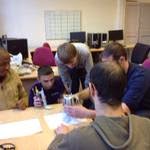Gary J. Hill
Published in Software Engineering Education Going Agile Part of the series Progress in IS pp 73-80
This paper, predominantly discusses the teaching of programming and problem solving to undergraduate first year computing students, using robots/robot simulators and visual programming to emulate the robot tasks. The needs to focus initial programming education on problem solving, prior to the teaching of programming syntax and software design methodology is also considered. The main vehicle for this approach is a robot/robot simulation programmed in Java, followed by the programming of a visual representation/simulation to develop programming skills.
References
- 1.Beaumont, C., & Fox, C.: Learning programming: Enhancing quality through problem-based learning. In: Proceeding of 4th Annual Conference of the subject centre for Information and Computer Sciences of the Higher Education Academy (pp. 90-95). Newtownabbey, Northern Ireland: Higher Education Academy (2003).
- 2.Hill G. J., Turner S.: Chapter 7: Problems First. In: Software Industry-Oriented Education Practices and Curriculum Development: Experiences and Lessons, M Hussey, X Xu & B Wu (Eds.), IGI Global, USA, pp 110-126, ISBN: 978-1-60960-797-5 (2011).
- 3.Hill, G., Turner, S. J.: Problems first, second and third. In: International Journal of Quality Assurance in Engineering and Technology Education (IJQAETE). 3(3), pp. 88-109. 2155-496X (2014).
- 4.Williams, A. B.: The qualitative impact of using Lego Mindstorms robot to teach computer engineering. In: Institute of Electrical and Electronic Engineering (IEEE) Transactions on Education, 46, 206 (2003).
- 5.Štuikys, V., Burbaitė, R., Damaševičius, R.: Teaching of Computer Science Topics Using Meta-Programming-Based GLOs and LEGO Robots. In: Informatics in Education - An International Journal (Vol12_1), pp125-142 (2013).
- 6.Kariyawasam, K., A., Turner, S., Hill, G.: Is it Visual? The importance of a Problem Solving Module within a Computing course. In: Computer Education, Volume 10, Issue 166, May 2012, pp. 5-7, ISSN: 1672-5913 (2012).
- 7.HEA-ICS Development Fund: HEA-ICS Development Fund [online] Available from: http://www.ics.heacademy.ac.uk/projects/development-fund/index.php[Accessed: February 2015] (2015).
- 8.HEA-ICS/Microsoft Innovative Teaching Fund: Developing problem-solving teaching materials based upon Microsoft Robotics Studio [online] Available from: http://www.ics.heacademy.ac.uk/projects/development-fund/fund_details.php?id = 88 [Accessed February 2015] (2015).
- 9.Adams, J. P., & Turner, S. J.: Problem Solving and Creativity for Undergraduate Engineers: process or product? In: International Conference on Innovation, Good Practice and Research in Engineering Education July 14-16, 2008, Loughborough, England, Higher Education Academy. 9781904804659 (2008).
- 10.Adams, J., Turner, S., Kaczmarczyk, S., Picton, P., & Demian, P.: Problem solving and creativity for undergraduate engineers: Findings of an action research project involving robots. In: International Conference on Engineering Education (ICEE 2008), Budapest, Hungary (2008).
- 11.Turner S., Hill G. J.: Robots in Problem-Solving and Programming. In: 8th Annual Conference of the Subject Centre for Information and Computer Sciences, University of Southampton, 28th - 30th August 2007, pp 82-85 ISBN 0-978-0-9552005-7-1 (2007).
- 12.Gallopoulos, E., Houstis, E., Rice, J. R.: Computer as Thinker/Doer. In: Problem-Solving Environments for Computational Science, IEEE Computational Science and Engineering pp 11-23 (1994).
- 13.Houghton, W.: How can Learning and Teaching Theory assist Engineering Academics? [online] School of Engineering - University of Exeter. Available from: https://www.heacademy.ac.uk/sites/default/files/learning-teaching-theory.pdf [Accessed: November 2015] (2004).
- 14.Bloom, B. S. (Ed.): Taxonomy of educational objectives. In: Handbook I: Cognitive domain. White Plains, NY: Longman (1956).
- 15.JICC5: Java & the Internet in the Computing Curriculum, Higher Education Academy (HEA) – Information and Computer Sciences (ICS) Conference, South Bank University, London, 22nd Jan, [online] Available from: http://www.ics.heacademy.ac.uk/events/displayevent.php?id=127[Accessed: February 2015] (2001).
- 16.Computing Curricula: IEEE CS, ACM Joint Task Force on Computing Curricula, IEEE Computer Society Press and ACM Press. [online] Available from http://www.acm.org/education/curricula.html [Accessed: February, 2015] (2001).
- 17.Koulouri, T., Lauria, S., Macredie, R., D.: Teaching introductory programming: A quantitative evaluation of different approaches. In: ACM Trans. Comput. Educ. 14, 4, Article 26 (December 2014), 28 pages, DOI: http://dx.doi.org/10.1145/2662412 (2014).
- 18.Turner S., Hill G. J.: The Inclusion of Robots Within The Teaching OF Problem Solving: Preliminary Results. In: 7th Annual Conference of the ICS HE Academy, Trinity College, Dublin, 29th - 31st August 2006, Proceedings pg 241-242 ISBN 0-9552005-3-9 (2006).
- 19.Turner S., Hill G. J.: Robots within the teaching of Problem-Solving. In: ITALICS, HEA-ICS, Volume 7 Issue 1, June 2008, pp. 108-119, ISSN: 1473-7507 (2008).
- 20.Turner S., Hill G. J.: Innovative Use of Robots and Graphical Programming in Software Education. In: Computer Education, Volume 9, May 2010, pp. 54-6, ISSN: 1672-5913 (2010).
- 21.Turner S, Hill G, Adams: Robots in problem solving in programming. In: 9th 1-day Teaching of Programming Workshop, University of Bath, 6th April 2009 (2009).
- 22.Gold. N.: Motivating Students in Software Engineering Group Projects: An Experience Report. In: Innovation in Teaching and Learning in Information and Computer Sciences 9(1), 10-19. DOI: 10.11120/ital.2010.09010010 (2010).
- 23.Greenfoot: Teach and Learn Java Programming. [online] Available from http://www.greenfoot.org/ [Accessed: February 1, 2015] (2015).
- 24.Microsoft: Microsoft robotics studio [online] Available from: http://msdn2.microsoft.com/en-us/robotics/aa731520.aspx [Accessed: February 2015] (2006).
- 25.Chickering, A. W., Gamson. Z. F.: Seven Principles for Good Practice in Undergraduate Education. In: AAHE Bulletin 39:3-7. ED 282 491.6 pp. MF-01; PC-01 (1987).
- 26.Savin-Baden, M. & Wilkie, K.: (eds) Challenging Research in Problem-based Learning. Maidenhead: Open University Press/SRHE (2004).
To read more go to: Review of a Problems-First Approach to First Year Undergraduate Programming - Springer
'via Blog this'
Posting on the site does not imply endorsement in any way, by the blog owner or any organisations the blog owner is associated with.
If you'd like to find out more about Computing at the University of Northampton go to: www.computing.northampton.ac.uk. All views and opinions are the author's and do not necessarily reflected those of any organisation they are associated with


